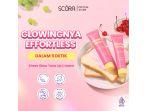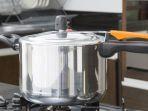Pendidikan
20 Contoh Soal UTBK SNBT 2023 dan Kunci Jawaban Literasi Bahasa Inggris
Cek deretan contoh soal UTBK SNBT 2023 dan kunci jawaban tentang literasi Bahasa Inggris.
Penulis: Briandena Silvania Sestiani | Editor: Amalia Husnul A
TRIBUNKALTIM.CO - Cek deretan contoh soal UTBK SNBT 2023 dan kunci jawaban tentang literasi Bahasa Inggris.
Pelaksanaan UTBK SNBT 2023 gelombang satu masih berlangsung, untuk kamu yang jadwal pelaksanaannya belum berlangsung masih bisa belajar materi yang akan diujiankan.
Salah satunya materi literasi Bahasa Inggris yang menjadi materi yang ada dalam UTBK SNBT 2023.
Tentu kamu perlu mempelajari berbagai contoh soal UTBK SNBT 2023 tentang literasi Bahasa Inggris.
Perlu diketahui, materi ujian UTBK SNBT 2023 terdiri dari 3 materi utama dengan 7 komponen atau subtes dengan jumlah sebanyak 155 soal yang dikerjakan selama 195 menit.
Dalam UTBK SNBT 2023, jumlah soal Literasi dalam Bahasa Indonesia dan Bahasa Inggris terdiri atas soal berbahasa Inggris sebanyak 20 soal dikerjakan selama 30 menit dan soal berbahasa Indonesia sebanyak 30 soal dikerjakan selama 45 menit.
Baca juga: 65 Contoh Soal UTBK SNBT 2023 dan Kunci Jawaban: Materi Bahasa Indonesia, Penalaran Umum, Matematika
Berikut 25 contoh soal SBMPTN bahasa inggris yang bisa dipelajari dengan pembahasannya yang dikutip dari RuangGuru dan Tribunnewsbogor.
1. In the US, consumers spend around $700 million a year keeping their fabrics soft. In the UK people spend £200 million a year on fabric softener. A giant manufacturer even claims a massive 50 percent share of the market. Despite the popularity, fabric softeners can be harmful to both the people who use them and the marine life that ends up swimming in them.
Fabric softening surfactants can be derived from animals, plants or minerals, as in the case of newer, silicone-based formulations. There is little difference between the chemicals used in fabric softeners and those used in hair conditioners. Whatever they are based on, all fabric softeners work in pretty much the same way, by depositing these surfactants onto the fabric to make it feel softer, reduce static cling, and impart a fresh fragrance.
Special fixatives in the mix of both standard and luxury conditioners mean that the fragrance can last for days, permeating wardrobes and drawers. The regular off-gassing of perfume chemicals from fabric softeners can be a significant trigger for asthma and other breathing problems. In the US, chemically sensitive individuals complain that, even after several washes, they cannot get the smell of fabric softeners out of their washing machines and dryers.
If you are a fabric softener addict, there are now a number of companies that provide alternative and ‘green’ fabric softeners. However, essentially, these are unnecessary products that can trigger health problems and can interfere with the functional aspect of some textiles. For instance, when used on towels and nappies, some fabric softeners can reduce absorbency, which is why it’s generally recommended that reusable nappies aren’t washed with them. Once they are washed down the drain they can become highly toxic to aquatic life. Given this, maybe it’s worth asking yourself whether the time has come to break the fabric softener habit completely.
The word permeating in the third paragraph is similar in meaning with ….
a. filling
b. soaking
c. charging










![[FULL] Kesaksian Murid yang Belajar di Markas PKI sebelum G30S, Ungkap Kondisi Sumur Lubang Buaya](https://img.youtube.com/vi/Y9-ffUbZuwc/mqdefault.jpg)





Isi komentar sepenuhnya adalah tanggung jawab pengguna dan diatur dalam UU ITE.